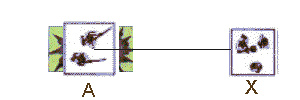Shelling Attack/Basic Indirect fire Resolution

Our first example examines the mechanics of resolving a simple shelling attack where
an on-board unit sees its target and fires at it (and we therefore don't need to resolve call-for-fire).
All indirect fire follows the same mechanism. You place one or more
indirect fire templates, determine what units are affected by it, and then resolve a separate
attack against each unit under the template. Note that an indirect fire template represents the fire of several actual
gun tubes. A good rule of thumb is that a template or gun model represents 2-3 tubes for mortars and 2 tubes for larger artillery.
Throughout the tutorial, we refer try to refer to "templates" rather than "guns", but keep this in mind if there is any confusion.
Step 1: Determine the Firing Unit, Target, and Observer
X, a veteran German 8cm mortar unit (card GE-52) in Good Order is emplaced 18" from a veteran American infantry unit A that is moving across an open field. Consulting the spotting chart, we see that a troop unit without concealment will normally be seen at 10". However, if the target is moving, the spotting distance will be moved up one on the Modified distance chart to 20". The German unit spots the American infantry.In the next German Offensive Fire Combat Phase, the mortar decides to attack the infantry using its indirect fire strength. Unlike direct fire, which is resolved in both the offensive and defensive fire phases, indirect fire occurs only in the offensive fire phase. If the target were within 5", the mortar would use its direct fire rating, representing the crew picking up their rifles and personal weapons and engaging in a firefight. However, because the range to the target is more than 5", the mortar uses its indirect fire modifiers (the yellow weapon ratings) and the attack is resolved as indirect fire even though the mortar can see its target.
Step 2: Determine the type of fire mission
The first step in the Offensive Fire Combat Fire Phase is to "Call for friendly indirect fire support". The mortar unit sees its target and is not attempting to combine its fire with any other unit, so it will use "Fire by Section" (p.36). Fire by section is restricted to "shelling" (p.39) and "smoke" missions (p.40). The mortar unit is attempting to damage the target, it will use a shelling mission instead of smoke. Shelling missions are the most basic type of indirect fire attack and are resolved without any die roll modification to the basic weapon rating because of the mission type.Step 3: Place the template
An indirect fire attack is initiated by placing the template representing the "beaten zone" (p.38) of the mortar on its target. Examining the unit card of the mortar, we see that it uses a small template. In 15mm scale, a small template is 2 1/2" by 1 3/4" and is represented by template C on the sheet provided with the game (the smaller ones are used for 1/285th scale) This template is placed on the target unit centered on the one of the aiming points of the target. Because the fire is being performed by an on-board unit, the template is aligned lengthwise along the direction of fire (p.37 Fig 34).Step 4: Determine if the attack arrives
Usually, a call-for-fire roll is performed to see if the indirect fire roll is successfully initiated. However, as the mortar unit spots its target, and is firing by section, the call for fire is automatically successful (p.38).Step 5: Resolve the attack
The indirect fire weapon rating of the mortar against T class targets is +0 out to 60". This is found in the yellow section of the T G sV line of the unit card. All types of fire combat are resolved using the Fire Combat table, but indirect fire attacks use only the indirect fire support modifiers. Looking down the Indirect Fire Modifiers, we see that the only one that applies is the discipline rating of +1 for good order veteran troops firing. A D10 is rolled with a +1 modifier, and the result cross-referenced into the Fire Combat chart against a veteran target. If a 5 were rolled, the modified die roll of 6 would result in a Suppressed result.In this example, there is only one target with an aiming point under the template. However, if there were more than one, every target with an aiming point under the template would be attacked, with a separate combat resolution made for each target.